Once at a College of Art in Maine it was peak performative darkroom schtick to point out the inadequacy of Ansel Adams. He was too good at focusing.
Among other things, Adams was a founding member of Group f/64; their manifesto opened: The name of this Group is derived from a diaphragm number of the photographic lens. It signifies to a large extent the qualities of clearness and definition of the photographic image which is an important element of the work of members of this Group.
The manifesto, unabashed in its denigration of the pictorialism that was popular at the time, was presumptuous. But its salient point was the smaller the aperture in a camera lens the greater the depth of field; in other words with a smaller aperture it is easier to achieve clear focus from foreground to background as is usually expected in a quality landscape shot.
At least that is the conventional wisdom based on a century or so of film photography.
Focus stacking has changed that. A photographer takes several identical frames changing only the primary focus point for each frame from foreground to background. This little library of identically framed shots are then treated as layers in photoshop, aligned, and then blended to yield one image with clear focus from the foreground to the distance. A tripod is a near necessity so the layers can be perfectly aligned.
As I played with this technique in the months since I purchased a high quality wide angle lens, I wonder whether Adams would consider this “simple and direct presentation through purely photographic methods….defined by the actualities and limitations of the photographic medium,” or would he consider it something else?
A single image. One of the seven used to make the composite above. Note the absence of the woman’s head at the foreground, only one hiker travels the far ridge-line on the right, and the sunlit patch in the bowl below Knife Edge is much narrower.
A trip to Katahdin promised great opportunities: long shots over the magnificent arête of the knife-edge, or a view to the horizon over the near endless ponds and lakes of northern Maine. A trial run to Monhegan’s oceanside cliffs would shake the bugs out. The weather on Monhegan, as in Baxter Sate Park is changeable. A drenching on the crossing from Port Clyde followed by a greasily humid and foggy four-and-a-half mile walk around the island taught me a few things.
Two camera bodies with lenses were not going to summit Katahdin. At about five pounds a piece, the pair, with associated gear, made the moderate challenge of Mohegan a gluey slog. Monhegan was a day hike; aside from camera gear I carried just a water bottle and a sandwich. Just one camera would make the trip to Katahdin. Second, a lighter tripod really wasn’t up to the challenge of the cliff side winds on Monhegan, but the sturdier one tips the scale at eight pounds. Presumably I’d have wind atop Maine’s highest mountain too.
Looking through the Baxter itinerary, the trail guides, and doing a pre-pack for days of backpacking it was plain that the tripod, even the light one, wouldn’t make the summit either. Although getting it to the summit from the campsite at Chimney Pond would be easy enough, getting it up to Chimney Pond was going to present problems. Water filters, rain gear, camp stoves, sleeping bags, food and other recommended gear took precedence. No one wants to be the guy evacuated as the ranger ruefully tells the Bangor Daily of yet another unprepared hiker. So the check list stuff was coming, the tripod—not on the checklist—was staying behind.
No wide angle lens, no tripod, no focus stacking. Just one camera and one lens, the pedestrian, but versatile, 24-120.
Standing on Baxter Peak looking over to South Peak and across the Knife Edge to Pamola I thought, just try it hand held. It’s not like you’re wasting film. The worst that could happen is that I’d have six or seven different images to play with; maybe a couple of them would line up well enough. To make up for my hands and the wind I pushed the ISO up to 320 and shot aperture priority at f/18. The focus point started on the rocks in the foreground and moved to South Peak on the right and then across the arête to the left ending up toward Pamola. There are seven images. Twenty-nine seconds passed between the first and seventh so just a few seconds each to pick a new focus point. while trying not to move my body or the camera.
In the stacked set of images notice a woman’s head emerging just above the last rock in the foreground; she only appeared in one of the original frames. On the ridge line in the distance at the right side of the frame you can see a hiker standing in silhouette. In the composite the hiker is not alone—his ghost is just behind the clear silhouette. My hiker made it into five of the seven original images. The hiker’s progress, or my movement, during the twenty-nine seconds left a whisper to plague the stacked mage.
I tried to cure this by picking just three of the images taken over ten-seconds—the three with borders that were most nearly identical—the result is the black and white image. Now rather than leaving a ghost the hiker left a near carbon copy just a step or two behind.
The final difference is that the clouds were scudding along at a good clip--this is pretty easy to see by looking into the bowl below the Knife Edge. In the composite the sun lit portion of the mountain is much wider.
Three images stacked. The real fix is just to get back up there with a tripod and the lens I want. Even so, I took a swipe at fixing the issues with my hand held composite by using just three images—the hiker’s ghost has changed form and seems more like a twin but is still there where it doesn't belong. You can see the sunlit patch is a bit smaller too wider than in the single image, but narrower than in the color composite. And with a hat-tip to Ansel I went ahead and converted it to B&W.
Here’s a link to an adobe how-to on focus stacking. There are a lot of YouTube presentations available too.
If you read Ansel Adams Autobiography you’ll see that his use of the phrase “missionary zeal” in the quotation below is no understatement.
“With high energy I began to explore a personal photographic direction based on the inherent qualities of the photographic process itself. I abandoned my textured photographic papers and began using the same smooth, glossy surfaced papers used by Paul Strand and Edward Weston to reveal every possible detail of the negative…I suddenly could achieve a greater feeling of light and range of tones in my prints. I felt liberated.
We (f/64) agreed with missionary zeal to a group effort to stem the tides of oppressive pictorialism and to define what we felt creative photography to be.
Group f/64 became synonymous with the renewed interest in the philosophy of straight photography: that is, photographs that looked like photographs not imitations of other art forms.”


